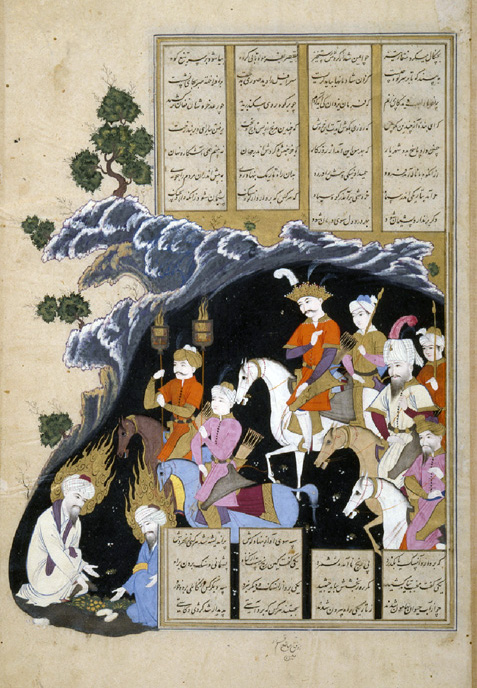The subject of the painting is clearly from the episode of Eskandar in the Land of Darkness. Precisely what juncture in that episode is being portrayed is not entirely clear; seemingly it may be an amalgam of two different sequences in the episode. The land of darkness is shown as a cavernous black tunnel depicted in cross-section, from which the front has been removed, permitting the viewer to observe the inside. A procession is moving in a leftward direction. The dominant personage in the group, near the center of the composition, is clearly Eskandar, who sits astride a white horse that vividly contrasts with the stark black background; he wears a red coat and a crown adossed with feathers. Accompanying him are six other mounted personage, three of whom can be identified as soldiers; they are proceeded by two mounted torch bearers. The sixth figure in the group is a distinguished bearded man of uncertain identification, dressed as an Ottoman, that is to say denoting a Rumi. Perhaps this was intended as Ḵeżr, who was the chief noble of the city of Harum and accompanied Eskandar in the Land of Darkness, but this identification is by no means certain for further to the left, in the marginal area, two turbanned men are seated conversing. Some stones, verdure, and perhaps a trickle of water are before them. Their flaming haloes identify them as prophets or religious figures, possibly the archangel Esrāfil and the prophet Ḵeżr. Those identifications are however problematic: Esrāfil is typically shown with wings, and Ḵeżr did not meet up with Esrāfil. Kühnel has identified these two figures as Ḵeżr and Elyās, but Elyās is not mentioned in this episode of the Shahnama. Above the cutaway section of the cavern the land is comprised of an undulating rock formation rendered in black, blue, and white, that forms a fantastic outcropping into the left margin where several small bushes grow. A gold sky is in the distance.
Painting: irregular shape 25.5 x 19.7 cm.The painting, which is one of the finest compositions in the manuscript,.is confined to the limits of the text on top and bottom and the frame on the right, but extends unhindered and irregularly into the left margin. There are four columns of text above and below the painting. Above each columns is comprised of either seven or eight lines of text, and below either three or four lines, but juxtaposed so that overall top and bottom each column consists of a total of eleven lines. The folio is signed in the lower margin in miniscule characters in Moʿin’s handwriting ze towfiq ṣānʿe raqam zad moʿin (Drawn with the grace of the Maker by Moʿin). Not dated.
For another variant of this episode, see Ms.G, f.299.
Painting references:
Kühnel, Survey_1939, pl.923; Kühnel, Pantheon_1942, fig.4;
Stchoukine, SA_1964, p.65 (not ill.).
Cambridge Shahnameh Project where it is identified as "Iskandar encounters Israfil"
Text references: Warner, VI, pp.158-62. Mohl, V, pp.172-73.
Robert Eng
Last Updated: January 12, 2011 | Originally published: May 7, 2003
